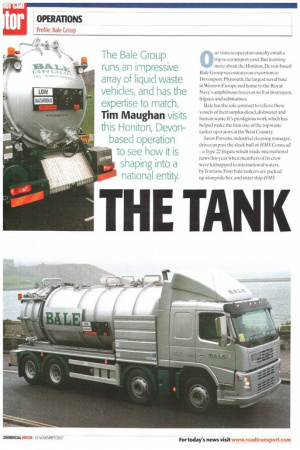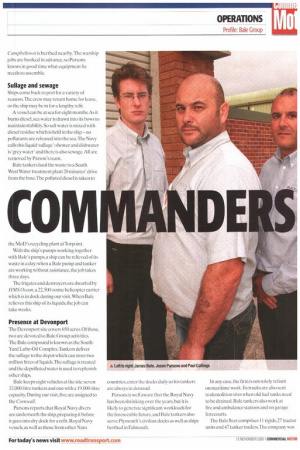THE TANK C
Page 54

Page 55

Page 56

If you've noticed an error in this article please click here to report it so we can fix it.
The Bale Group runs an impressive array of liquid waste vehicles, and has the expertise to match.
Tim Maughan visits this Honiton, Devon based operation to see how 'rt is shaping into a
national enti-y. 0 ur visits to operators usually entail a trip to a transport yard. But learning more about the Honiton, Devon-based Bale Group necessitates an excursion to Devonport. Plymouth, the largest naval base in Western Europe and home to the Royal Navy's amphibious forces as well as destroyers. frigates and submarines.
Bale has the sole contract to relieve these vessels of their surplus diesel, dishwater and human waste. It's prestigious work which has helped make the firm one of the top waste tanker operators in the West Country.
Jason Parsons, industrial cleaning manager, drives us past the sleek hull of HMS Cornwall — a Type 22 frigate which made international news this year when members of its crew were kidnapped in international waters by Iranians. Four bale tankers are parked up alongside her, and sister ship HMS
Campheltown is berthed nearby. The warship jobs are booked in advance, so Parsons knows in good time what equipment he needs to assemble.
Soilage and sewage Ships come hack to port for a variety of reasons.The crew may return home for leave, or the ship may be in for a lengthy refit.
A vessel can be at sea for eight months. As it burns diesel, sea water is drawn into its bows to maintain stability. So salt water is mixed with diesel residue which is held in the ship — no pollutants are released into the sea.The Navy calls this liquid 'sullage'; shower and dishwater is'grey water' and there is also sewage. All are removed by Parson's team.
Bale tankers haul the waste to a South West Water treatment plant 20 minutes' drive from the base.The polluted diesel is taken to the MoD's recycling plant at Torpoint.
With the ship's pumps working together with Bale's pumps. a ship can be relieved of its waste in a day; when a Bale pump and tanker are working without assistance, the job takes three days.
The frigates and destroyers are dwarfed by HMS Ocean, a 22,500-tonne helicopter carrier which is in dock during our visit.When Bale relieves this ship of its liquids, the job can take weeks.
Presence at Devonport The Devonport site covers 650 acres. Of these, Iwo arc devoted to Bale Group activities. The Bale compound is known as the South Yard Lube-Oil Complex.Tankers deliver the sullage to the depot which can store two million litres of liquids.The sullage is treated and the depolluted water is used to replenish other ships.
Bale keeps eight vehicles at the site: seven 32,000-litre tankers and one with a 19,000-litre capacity. During our visit, five are assigned to the Cornwall.
Parsons reports that Royal Navy divers are underneath the ship, preparing it before it goes into dry dock for a refit. Royal Navy vessels, as well as those from other Nato countries, enter the docks daily so his tankers are always in demand.
Parsons is well aware that the Royal Navy has been shrinking over the years, but it is likely to generate significant workloads for the foreseeable future, and Bale tankers also serve Plymouth's civilian docks as well as ships berthed in Falmouth. In any case. the firm is not solely reliant on maritime work. Its trucks are also sent to demolition sites when old fuel tanks need. to be drained. Bale tankers also work at fire and ambulance stations and on garage forecourts.
The Bale fleet comprises II rigids,27 tractor units and 47 tanker trailers:the company was established by directorTony Bale in 1998 (see panel) and is split into four divisions: Transport, Fabrications, Special Services and Environmental The Transport arm turns over the best part of £9m in its own right.
Many liquid waste outfits operate on a local or a regional basis, but transport manager Paul Collings points out that his fleet ventures much further afield:"Our guys leave Honiton or Swindon on a Monday morning, then return on a Friday afternoon or a Saturday morning. We operate up to Liverpool." Sleeper cabs enable drivers to stay away for long periods. Driver James Davies For our pictures we liaise with Collings and driver James Davies on a windswept Plymouth seafront. Some of the firm's customers -Royal Navy warships -can be seen anchored a mile or so out at sea.
Davies drives a Volvo 32tonner with a tipper body and a pump capable of sucking up water from 25in below ground level.
"One of the things about this truck is the side as well as rear suction," he says. "So it's good in confined spaces. It's simplicity."
The tipper-tanker's control panel is located at the rear of the vehicle: "It means you have your finger on the pulse." •


























































































































































































